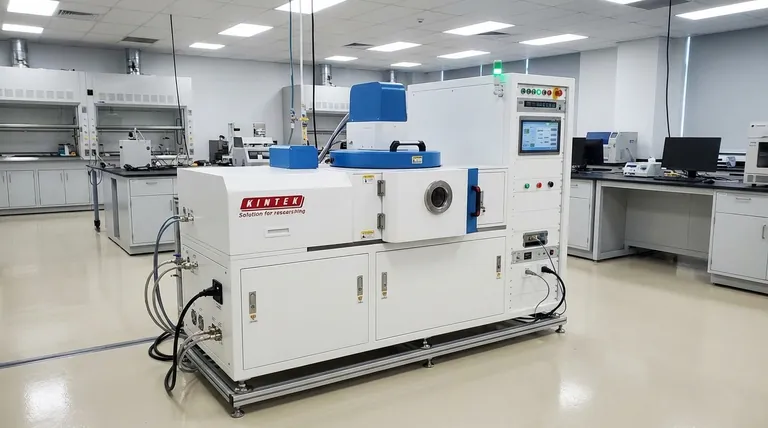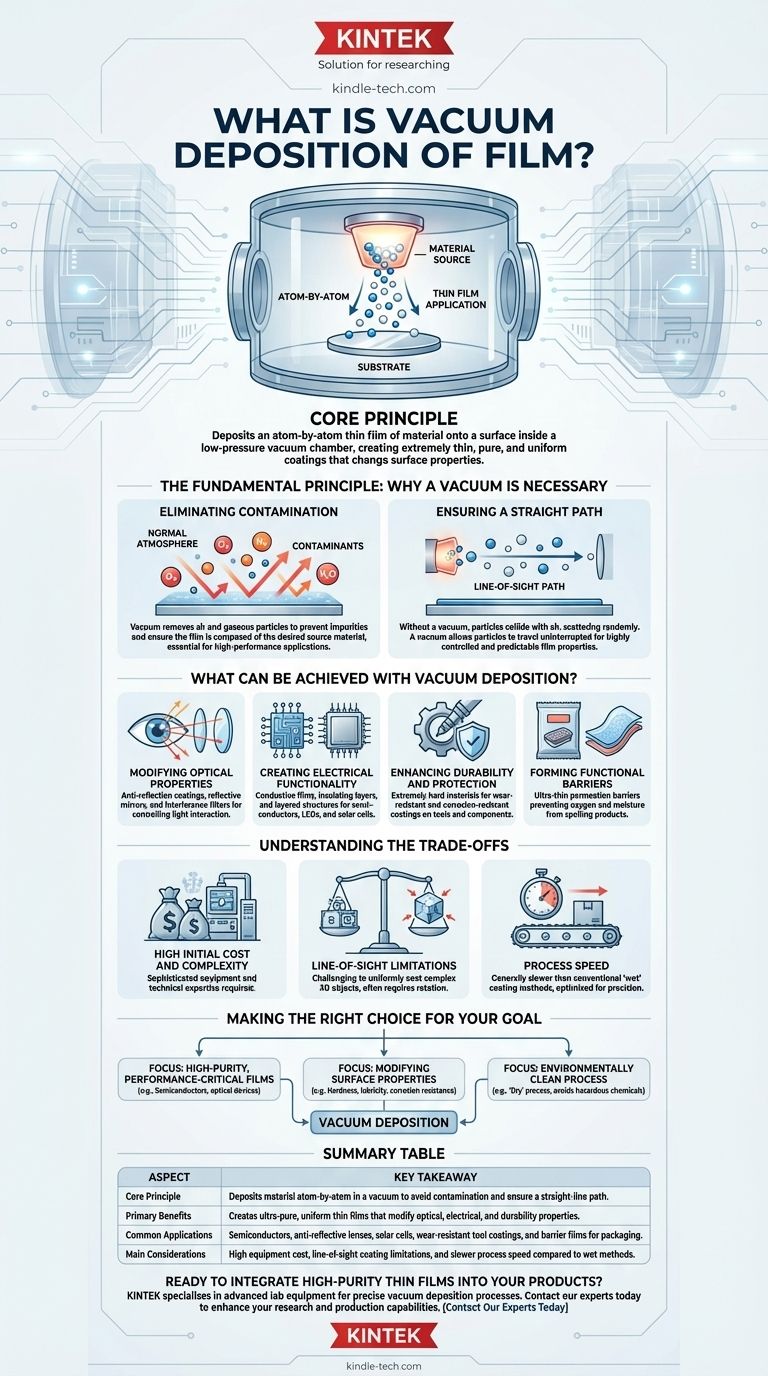At its core, vacuum deposition is a family of processes used to apply an atom-by-atom thin film of material onto a surface inside a low-pressure vacuum chamber. This technique allows for the creation of extremely thin, pure, and uniform coatings that can fundamentally change the properties of the underlying object, known as the substrate.
The essential purpose of using a vacuum is to remove air and other gaseous particles. This ensures the coating material can travel from its source to the target surface without contamination or collision, resulting in highly controlled and predictable film properties that are impossible to achieve in a normal atmosphere.

The Fundamental Principle: Why a Vacuum is Necessary
To understand vacuum deposition, you must first understand why removing air is the critical first step. The process is defined by the environment it creates.
Eliminating Contamination
In a normal atmosphere, a surface is constantly bombarded by particles like oxygen, nitrogen, and water vapor. These particles would become trapped in the thin film as it forms, creating impurities.
A vacuum chamber removes these contaminants, ensuring the deposited film is composed almost exclusively of the desired source material. This purity is essential for high-performance applications like semiconductors and optical lenses.
Ensuring a Straight Path
Once a vacuum is established, the particles of the coating material can travel from their source to the substrate in a straight, uninterrupted line. This is often called a "line-of-sight" path.
Without a vacuum, these particles would collide with air molecules, scattering randomly and preventing them from forming a dense, uniform film on the substrate.
What Can Be Achieved with Vacuum Deposition?
By precisely controlling the deposit of material at an atomic level, vacuum deposition can impart a wide range of powerful new properties to a surface.
Modifying Optical Properties
Thin films are used to control how light interacts with a surface. This includes anti-reflection coatings on eyeglasses and camera lenses, reflective mirror coatings, and complex interference filters that allow only specific colors of light to pass through.
Creating Electrical Functionality
This process is the bedrock of the modern electronics industry. It is used to deposit conductive films for circuitry, insulating layers in microchips, and the layered structures required for semiconductor devices, LEDs, and solar cells.
Enhancing Durability and Protection
Extremely hard materials can be deposited as thin films to create superior wear-resistant coatings on cutting tools and industrial components. Likewise, corrosion-resistant coatings can protect materials from harsh environments.
Forming Functional Barriers
In the packaging industry, an ultra-thin, transparent film of material like aluminum oxide can be deposited on a flexible polymer. This creates an exceptional permeation barrier, preventing oxygen and moisture from spoiling food without affecting the package's clarity.
Understanding the Trade-offs
While powerful, vacuum deposition is not a universal solution. It involves specific complexities and limitations that make it suitable for some applications but not others.
High Initial Cost and Complexity
Vacuum deposition requires sophisticated and expensive equipment, including vacuum chambers, high-power pumps, and specialized material sources. Operating this machinery demands significant technical expertise.
Line-of-Sight Limitations
Because the coating material travels in a straight line, it can be challenging to uniformly coat complex, three-dimensional objects with hidden surfaces. This often requires complex rotating fixtures within the chamber to ensure all sides of the substrate are exposed to the source.
Process Speed
Compared to conventional "wet" coating methods like painting or electroplating, vacuum deposition is generally a slower, more deliberate process. It is optimized for precision and purity, not mass-volume coverage at high speed.
Making the Right Choice for Your Goal
Vacuum deposition is selected when the performance and precision of the coating are paramount.
- If your primary focus is high-purity, performance-critical films: Vacuum deposition is the industry standard for applications like semiconductors, optical devices, and solar cells where purity dictates function.
- If your primary focus is modifying surface properties: This process is ideal for adding hardness, lubricity, or corrosion resistance to a component without changing the properties of the underlying bulk material.
- If your primary focus is finding an environmentally clean process: Vacuum deposition is a "dry" process that avoids the hazardous chemicals and waste disposal issues associated with traditional wet methods like chrome electroplating.
Ultimately, vacuum deposition is an enabling technology that makes many of the devices and high-performance products we rely on every day possible.
Summary Table:
| Aspect | Key Takeaway |
|---|---|
| Core Principle | Deposits material atom-by-atom in a vacuum to avoid contamination and ensure a straight-line path. |
| Primary Benefits | Creates ultra-pure, uniform thin films that modify optical, electrical, and durability properties. |
| Common Applications | Semiconductors, anti-reflective lenses, solar cells, wear-resistant tool coatings, and barrier films for packaging. |
| Main Considerations | High equipment cost, line-of-sight coating limitations, and slower process speed compared to wet methods. |
Ready to integrate high-purity thin films into your products?
KINTEK specializes in providing the advanced lab equipment and consumables necessary for precise vacuum deposition processes. Whether you are developing next-generation semiconductors, optical coatings, or durable protective layers, our expertise ensures you have the right tools for success.
Contact our experts today to discuss how our solutions can enhance your research and production capabilities.
Visual Guide

Related Products
- RF PECVD System Radio Frequency Plasma-Enhanced Chemical Vapor Deposition RF PECVD
- Chemical Vapor Deposition CVD Equipment System Chamber Slide PECVD Tube Furnace with Liquid Gasifier PECVD Machine
- Customer Made Versatile CVD Tube Furnace Chemical Vapor Deposition Chamber System Equipment
- Split Chamber CVD Tube Furnace with Vacuum Station Chemical Vapor Deposition System Equipment Machine
- 1700℃ Controlled Atmosphere Furnace Nitrogen Inert Atmosphere Furnace
People Also Ask
- What is the principle of plasma enhanced chemical vapor deposition? Achieve Low-Temperature Thin Film Deposition
- What are the benefits of PECVD? Achieve Superior Low-Temperature Thin Film Deposition
- Why does PECVD commonly use RF power input? For Precise Low-Temperature Thin Film Deposition
- What is plasma activated chemical vapour deposition method? A Low-Temperature Solution for Advanced Coatings
- Why is PECVD environment friendly? Understanding the Eco-Friendly Benefits of Plasma-Enhanced Coating



















